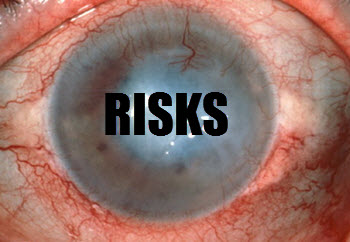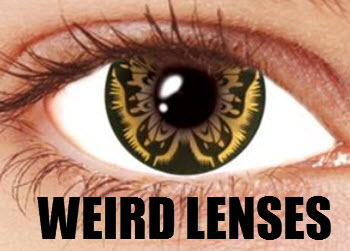Scleral Lenses: A Comprehensive Overview
The use of scleral lenses has grown significantly in the special effects industry, paralleling advancements in technology and materials engineering. Originally developed for medical purposes, scleral lenses have unique characteristics that have made them increasingly popular in film, television, and theatrical productions.
Understanding Scleral Lenses
Scleral lenses are a type of contact lens characterized by their larger diameter, typically ranging from 14.5 to 24 millimeters. Unlike traditional contact lenses, which rest on the cornea, scleral lenses vault over the cornea and rest on the sclera, the white part of the eye. This design not only provides greater comfort but also a more stable fit, ideal for prolonged use in performance settings.
The science behind scleral lenses is intriguing as they function by creating a tear-filled vault over the cornea. This not only protects the sensitive corneal tissues but also provides a cushion of fluid that can be beneficial for individuals with severe dry eyes or corneal irregularities. Over the years, their use has expanded beyond medical applications to include enhancements in theatrical and cinematic productions, where they make an excellent tool for visual transformation.
Popularity in Special Effects
The rising popularity of scleral lenses within the special effects community can largely be attributed to their ability to completely cover the visible portion of the eye, enabling dramatic transformations. When incorporated into character design, these lenses can create anything from otherworldly creatures to demonic entities, effectively enhancing the visual storytelling. Their comprehensive coverage allows artists to change the color, texture, and appearance of a character’s eyes, transforming them into anything from mythical beings to horror figures.
In productions where detail is critical, such as in high-definition films and television, the ability of scleral lenses to maintain their appearance from multiple angles offers a substantial advantage. These lenses can create an uninterrupted visual effect, which is crucial in maintaining audience suspension of disbelief. This quality makes them especially valuable in genres where realism and visual impact are paramount, such as in horror, fantasy, and science fiction settings.
Material Advancements
Historically, contact lenses were made from hard materials that often caused discomfort. With advancements in polymer technology, modern scleral lenses are crafted from highly breathable materials that allow for oxygen permeability, reducing the risk of complications and making them safer for extended wear. This technological progress in materials science has revolutionized the comfort level and safety of scleral lenses, making them a viable and sustainable option for actors who need to wear them for long durations.
Oxygen permeability is critical because it allows necessary oxygen to reach the cornea, maintaining corneal health. This advancement has significantly reduced incidences of hypoxia-related complications, which were more common with older lens technologies. Additionally, the materials used have a hydrophilic quality, meaning they attract and retain water, which leads to a moist lens surface and a more comfortable wearing experience.
Customization Possibilities
One of the key benefits of scleral lenses in special effects is their high degree of customization. They can be painted or tinted to any specification, allowing makeup artists and designers to craft intricate and unique looks tailored to production needs. This flexibility has been a game-changer in how creators approach character design.
The paints and colors used are often specifically designed to ensure they do not compromise the wearer’s vision or the lenses’ structural integrity. Artists use proprietary methods to apply color in ways that are durable and enduring, resistant to wear and tear despite the rigorous environments of film sets. This customization enables the crafting of eyes reminiscent of creatures from lore and mythos, visually accentuating characters in ways that traditional makeup or digital effects cannot achieve alone.
Application and Safety Considerations
While scleral lenses offer extensive creative possibilities, their application requires meticulous attention to safety. Proper fitting by a licensed eye care professional is essential to avoid eye damage and ensure comfort. Regular maintenance is also crucial to prevent infections and other health issues.
To ensure lenses are worn safely, comprehensive pre-production planning is necessary. Planning involves consultations with optometrists or ophthalmologists who can custom-design lenses for a perfect fit. This step is vital because improper fitting can lead to discomfort, redness, and in severe cases, corneal abrasions and infections. Hence, adherence to recommended safety procedures is as crucial as the creativity involved in their design and use.
Professional Handling
Due to their size and unique application method, scleral lenses should always be handled by trained personnel. Actors and performers must receive thorough instructions on insertion, removal, and care to maintain optimal eye health. Given their complexity, these procedures often require assistance from a lens technician or optometrist on set. This ensures that the lenses are worn and handled correctly, minimizing risk to the performers.
Standard practice involves cleaning the lenses thoroughly and storing them in recommended solutions designed to maintain hygiene and lens integrity. Training actors on how to manage these lenses safely is part of a broader strategy to maximize their performance effectiveness while minimizing any adverse health impacts.
Adoption in the Industry
The adoption of scleral lenses within the film and television industry has been facilitated by their cost-effectiveness and the striking impact they have on the audience. As technology continues to evolve, the role of scleral lenses in special effects is expected to expand further, offering new opportunities for innovation in visual storytelling.
Their cost-effectiveness compared to other effects tools, such as CGI, cannot be overstated. While digital tools offer some advantages, scleral lenses provide a tangible real-world impact that enhances the realism and depth of scenes. The resulting visual appeal of using lenses over reliance on visual effects positions them favorably as a practical, cost-effective tool for artists looking to push the envelope in narrative authenticity and audience engagement.
With continuing advancements in their design and material science, the future of scleral lenses in special effects looks promising. Innovators in the film and theater industry are likely to explore new dimensions in using these lenses, broadening the perspectives of audiences and redefining how visual effects are integrated into production.



 Cosmetic contact lenses
Cosmetic contact lenses